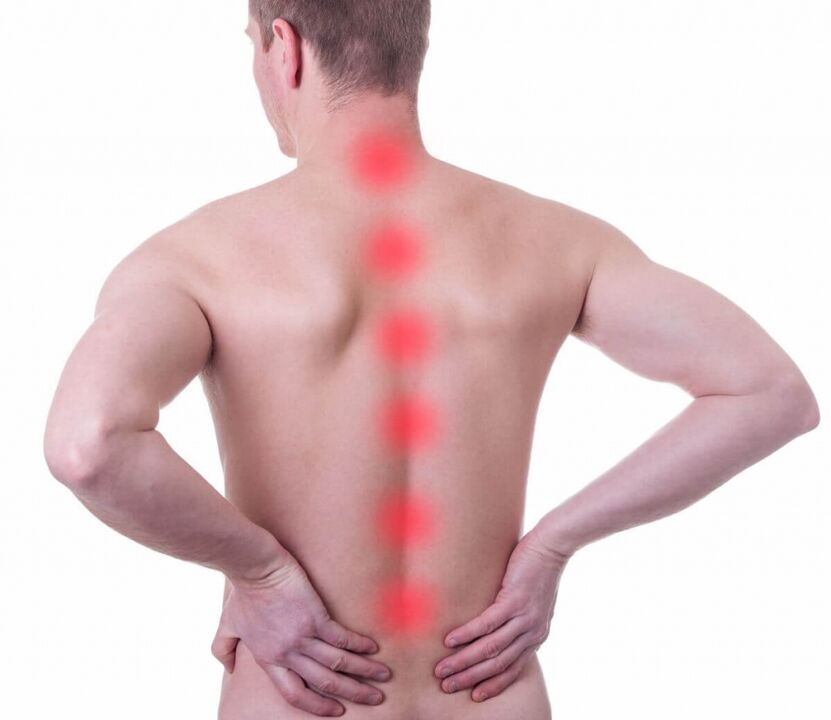Nowadays, back pain is one of the common reasons people seek professional advice. According to some data, it occurs at least once in life in at least 80% of the adult population and at least 4-9% annually seek professional advice about it. Feeling pain just above the lumbar area, in the back is one of the common symptoms. In this article we will talk about what problems can cause pain in this area, how to identify them, and also touch on the topic of combating them.
Several causes can cause pain
The majority of pain cases in the back and lumbar region are musculoskeletal pain, which can be caused by osteoarthritis, myositis and intervertebral herniation. However, it can also be caused by other pathologies, as well as certain conditions of the human body. Let's look at some common reasons.
Osteocartilage degeneration
Or, according to the terminology applied today in the international classification of diseases - back pathology. These are dystrophic changes in the cartilaginous tissue of the intervertebral disc, compensating the load on the spine, providing shock absorption during movement, vibration loads, etc. v. In most cases, pathology can appear due to genetic predisposition, as well as sedentary and sedentary lifestyle and lack of physical activity.
Muscle pain
These are muscle pains that can be caused by many reasons. Just above the lower back are the muscles that hold and stabilize the spine. Therefore, the reason for painful sensations in them can be due to various diseases of the spine, as well as increased physical activity, hypothermia, etc. v.
Intervertebral hernia
This is one of the complications of spondylosis, in which the integrity of the disc is broken and the fluid core located inside protrudes into the spinal canal. Depending on the size of the hernia and its location in the back, sharp pains may occur, sometimes spreading to other parts of the body and limbs (with pathology above the lower back, thiscould be legs or arms).
Diseases of internal organs
Back pain is not always a sign of a spine problem. Often it can also be a symptom of pathologies of internal organs: gastric and duodenal ulcers, pancreatitis, cholecystitis, urolithiasis, kidney disease, etc. v. However, it is not always painful in the abdomen, side or other area where the affected organ is located. .
Age-related changes
With age, the structure of the spine undergoes a number of changes, which are especially noticeable with a sedentary lifestyle and reduced load. They are related to the ligamentous apparatus, muscles and bone tissue. Osteoarthritis and osteoarthritis, combined with muscle atrophy and loss of ligament elasticity, can periodically cause pain in the lumbar region.
Pregnancy
Back pain is not always a sign of any medical condition. For example, late pregnancy can also cause this condition in women. According to available data, 90% of pregnant women complain of back pain, and 50% of discomfort is localized specifically in the lumbar region. But why does this happen? It is caused by physiological changes in the biomechanics of the pelvis and spine. In most cases, pain can occur in women who have previously had back problems.

Types of painful sensations
Understanding the type of pain a person is experiencing is important for diagnosis. Back pain above the lower back can be lumbar pain, aching, pulling, dull, aching, etc. v. Feelings are just additional data used in diagnosis. You should not rely solely on them, much less self-diagnose based on this information alone.
Several diagnostic methods are possible
During the qualifying consultation, medical history and data on symptoms will be collected. However, this is not enough: further examination is required for a more accurate diagnosis. The specialist can limit himself to one of them or prescribe several.
X-ray
This is a diagnostic technique based on the use of X-rays. With the help of such an examination, it is possible to identify fractures, osteochondrosis of the spine, spondylosis, neoplasms, as well assuch as curvature and other disorders. When performing an x-ray, the image of the organ being studied is projected onto film or paper in just one exposure - this method is less informative than CT and MRI x-rays.
X-ray computed tomography (X-ray computed tomography)
X-ray CT is similar to radiography in the technology used: it is also based on X-ray radiation. However, the result of such diagnostics is not a 2D image but a 3D image is obtained, which hasavailable to study each class. To do this, stronger ionizing radiation is used, which should not be used too often. RCT can be performed with or without contrast, which provides clearer images and increases the likelihood of successful diagnosis of certain diseases.
MRI
Magnetic resonance imaging is a diagnostic method that also allows one to obtain multilayer images in several projections, but does not involve the use of X-rays. It is based on magnetic resonance and is therefore safebetter than X-rays and CT scans, but not suitable for patients with permanent metal structures in the body. Additionally, this study was noisier and longer. Like CT, MRI can be performed with contrast to more accurately diagnose certain diseases.
Supersonic
This technique is based on the principle of echolocation and, as a rule, is used to diagnose diseases of internal organs if symptoms give reason to suspect their presence. It is informative and safe in the study of organs and tissues. Spinal ultrasound is also performed but is extremely rare.
Laboratory diagnosis
To diagnose the inflammatory process, the presence of infection or tumors, a general blood test with the ESR leukocyte formula may be prescribed. In the future, if pathology of internal organs is suspected, additional laboratory tests may also be prescribed.
Other diagnostic methods
If a specific nature of the pain or visceral disease is suspected, other tests may be ordered until the diagnosis is established and the cause of the pain is determined.

Treatment of back pain above the lumbar region
The most important step to getting rid of back pain is to get expert advice. After diagnosis, exclusion of diseases of internal organs, serious pathologies of the spine and determination of pain as nonspecific, the following can be recommended:
- taking NSAIDs.Non-steroidal anti-inflammatory drugs for topical and internal use are often used to relieve non-specific back pain, osteoarthritis, hernia and other pathologies. This drug includes the active ingredient in the preparation - nimesulide;
- Use muscle relaxants.They are designed to help prevent muscle spasms, thereby improving mobility and reducing pain;
- taking other medications.For diseases of internal organs or back pain during pregnancy, the set of medicines will most likely be different;
- Physical therapy and exercise therapy.During the acute phase, various physical procedures may be recommended to relieve pain and accelerate improvement. For example, they include electrophoresis with analgesics, pulsed electric current, ultraviolet irradiation, massage, therapeutic exercise, as well as mineral baths, mud therapy, etc. v. ;
- surgical intervention.Surgery may be indicated for a herniated disc if other methods of pain relief do not provide long-term results and may also be indicated based on the results of an MRI, X-ray or X-ray.

Some possible preventative measures
Because risk factors for developing musculoskeletal back pain, including those above the lumbar region, include heavy work, a sedentary lifestyle, as well as frequent bending, heavy lifting, and shaking, these factors should be minimized. as a preventative measure. If your back already hurts above the lower back, you should not immediately overload your muscles with gymnastics and especially sports - you should first seek professional adviceto rule out diseases.
























